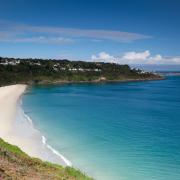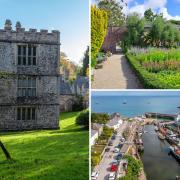The busy market town of Launceston dominates the land between the West country's great moors Bodmin and Dartmoor

IAN WILKINSON talks to Nigel Bowman, joint owner of the , about the town's attraction...
The busy market town of Launceston dominates the land between the Westcountry's great moors Bodmin Moor and Dartmoor. In fact the town owes its very existence to this strategic position as evidenced by the magnificent Norman castle that commands the river crossing and the surrounding countryside. The Castle became the headquarters of the great Earls of Cornwall and it was from this seat of power that they controlled their enormous estates.

Their great wealth and influence contributed to the prosperity and growth of the town and by the mid 19th century, Launceston was the administrative centre of the county. Today it is a thriving local centre with some excellent shops, some fine Georgian architecture and a magnificent 14th-century parish church. The best way to see the town is on foot and to help you its worth visiting the Tourist Information Centre in the recently restored Market House, where the friendly staff will provide you with a map of Launceston's Town Trail.
Not to be missed of course is the Castle that is beautifully maintained by English Heritage, the parish church of St Mary Magdalene with its exquisite exterior carvings and Lawrence House the towns museum. Shopping-wise Southgate Street and Church Street are the places to head for a specialist shops, selling all sorts including rare books, hardware and local produce.
In the 13th century, when Launceston was a walled town, the new suburb of Newport developed around the Augustinian Priory. To the west of the town, at the bottom of the hill from the castle visit the roundhouse, a delightful riverside walk, an ancient inn, a medieval footbridge spanning the river Kensey and the church of St Thomas.
Many visitors to this part of the town come to see the popular Launceston Steam Railway and it was in the quaint station building that I met joint owner of the railway, Nigel Bowman. It is now over 40 years since Nigel and his two co-directors began to purchase the track bed of the former north Cornwall line. He tells me about his early life and the circumstances leading to the purchase and development of the railway.

'I was born in Guildford. My father and grandfather were both engineers and it therefore seemed natural for me to be educated in one of the few technical colleges that existed at the time. When I was 19, a friend introduced me to the slate quarries of north Wales and narrow gauge internal railways.
'It was at Penrhyn Quarry that I first met Lilian, a delightful little steam engine built by the Hunslet Engine Company in 1883. She was in a pretty derelict state and I paid 60 for her, which in 1964 was about all I had to my name!'
During the restoration work to Lilian, Nigel met a farmer whose mission in life was to save and restore old steam engines and it took little persuasion for him to give up his teaching job and return to his engineering roots by making the parts needed to get the engines up and running.
With Lilian now restored to her former glory, Nigel began the search for a suitable stretch of line to run her on. I tried to buy a disused line in the South East but the development value of the land was prohibitive. So I started looking at other parts of the country and because I had some friends in Launceston who were railway-minded, I wrote a nave letter to the local council. Much to my surprise, the next day I received a phone call from Dick Thorne, the Borough Surveyor who was extraordinarily helpful and enthusiastic and it all started from there!

A promising start, but it took 13 years for Nigel, his wife Kay and his co-directors to complete the land purchase and it was not until Boxing Day 1983 when Lilian hauled her first passengers along the re-opened line.
Nigel describes his life in Launceston and the surrounding area when he is not driving engines, laying new track, or managing the railway. 'Kay and I are happy to spend time at home and I quite enjoy just tinkering about in the workshop. We both enjoy the surrounding countryside and often take a picnic out with us at weekends. Lots of our customers like to go to the Eliot Arms in nearby Tregadillet. Its a historic 17th-century inn and its absolutely charming.
Nigel continues: 'There are a couple of nice tea rooms in Launceston itself but one of the best is of course right here in the station! We sell traditional Cornish cream teas and a very good range of cakes. The produce is locally sourced and we buy as much as we can from the town. The fruit and vegetables are always fresh and the two bakeries, Barnecutts and Parkers are excellent. Even the ice cream is local Gerry's Original comes from a small shop in White Hart Arcade and its delicious! We know, because we taste everything ourselves first. If the staff don't like it, then we don't sell it!
'Kay and I like to go to quiet, beautiful places, 'Nigel says. 'A favourite spot of ours is Millook, a little-known cove on the north coast. Or we might go for a walk on Bodmin Moor as is very easy to get to from Launceston. If friends come to stay we often take them out into the countryside to explore Cornwall's mining heritage - to places they are never likely to have seen or experienced.

'The area around Caradon Hill and in particular Minions is really interesting and we've even managed to get underground on occasions.'
Nigel adds that you don't have to leave Launceston for some really interesting history. Apart from the castle, just outside the station you will find the ruins of the 12th century Augustinian Priory. It was lost for centuries and rediscovered in the late 1800s when they built the railway. A couple of years ago, it was rescued by a conservation scheme initiated by Launceston Town Council and its well worth seeing now.
launcestonsr.co.uk





























